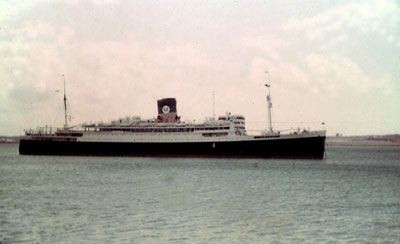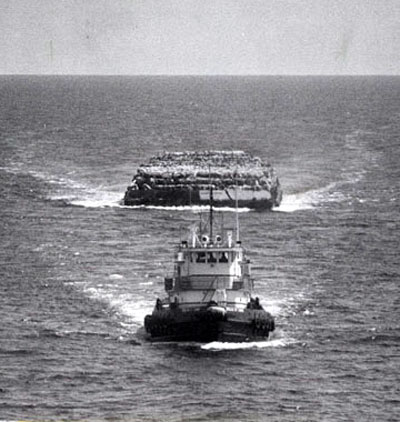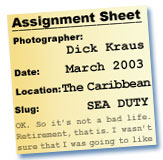SEA DUTY
By Dick Kraus
Newsday Staff Photographer
Retired
OK. So it’s not a bad life. Retirement, that is. I wasn’t
sure that I was going to like it. I’ve been a working news
photographer for over 40 years and I was sure that I would be bored
out of my gourd, not working every day.
But, I’ve been able to get myself psyched by keeping myself
busy with various projects, one of which is editing and contributing
to this feature and by shooting the pictures that I wanted to make
and not because I had to. And having the time to do all of
these things and to do some things that I’ve never been able
to do in the past.
Like today. I’m sitting alongside the pool on deck 11 of a
luxury cruise ship in the Caribbean, trying to concentrate on this
journal but constantly being distracted by nubile young women in
bikinis. And now the steel band is tuning up. Ahhh, but I digress.

The Adventure of the Sea. Length: 1,020'. Passenger capacity:
3,114.
© Photo by Dick Kraus
|
|
I
am reminded of other days at sea. Believe it or not, one
of the first photographic jobs that I ever had was on cruise
ship, 52 years ago. I was 18 and just out of high school
and a couple of courses at a commercial photo school. I
was waiting to be called into military service during the
Korean
War. Through the school, I was offered a position as an
assistant to the ship’s photographer aboard one of
Moore McCormack’s
cruise ships, the SS Brazil, from New York City to South
America. It was a three week cruise and for an eighteen
year old kid,
quite a golden opportunity. Compared to the ship upon which
I am writing this, it was a row boat, but in it’s
day, the Brazil was considered First Class. Think about
this,
though. That ship had about 7 decks and carried about 400
passengers. This ship has 14 decks and carries over 3,000
passengers. There was just the photographer and myself,
and the work wasn’t very hard. There must be about
eight photographers on this ship and they are always busting
their chops from morning to night.
I got
to see some exotic places, like Trinidad, Rio de Janeiro, Caracas,
Montevideo and Buenos Aires and I loved it. I had enlisted in
the US Navy before I left and after this cruise was over, I was
sure that I had made the correct choice. I loved life at sea
and travel to foreign ports. I had no illusions that life aboard
a navy ship would be anything like luxury cruising. But, I was
ready to go to sea. |

The SS Brazil. A lot smaller.
© Photo by Dick Kraus |
|
Four
years I spent in the navy. And not one day of which was ever
aboard a ship. When my four year enlistment was up, I had to
listen
to a re-enlistment spiel. I was told that if I re-upped, I would
be guaranteed shore duty.
“
Why,” I asked.
“
Because your record shows that you already have four years of sea
duty,” I was told.
“
Are you sure that you have the right records in front of you? I joined
the Navy to go to sea and never spend a day aboard ship,” I
said.
“
Ahh, that may be,” said the Personnel Officer. But you flew
for two years (I was an Aviation Photographer’s Mate) and you
spent two years overseas (Naples, Italy.) That all counts as sea
duty.”
I turned down the offer and returned to civilian life. I finally
got my sea duty, but it was as a Newsday Photographer. Newsday
publishes on Long Island (NY) and we are surrounded by water. During
my career,
I had ample opportunity to cover stories on the water.
One of the first was one of the most unusual. I had to drive up
to Groton, CN where I met with a bunch of Sea Scouts who were going
to spend a day aboard a navy sub during a training mission. Our
boat
was a World War II era diesel sub. No fancy nuclear subs for us.
The first thing that I learned when I stepped aboard was that being
6’ 4” was an impediment. Everywhere you went on the sub
meant stepping through hatches (doors) which required one to step
over a combing while ducking under a low opening. Step and duck.
Step and duck. Step and “OUCH! OH, SHIT!.” I never got
the timing down and I carry scars on my forehead to this day.
The salty old Chief Bos’n’s Mate who put us aboard wished
us a good voyage. Then he added, “May you surface as often
as you submerge.” Hmmmm. We made about eighteen training dives,
under the waters of Long Island Sound, and we surfaced an equal number
of times, and that is a very good thing.
During the many OpSail events held in NYH Harbor, I spend days
aboard chartered cabin cruisers, getting up close and personal
with naval
ships from many nations, as well as an assortment of some of the
most beautiful sailing ships of the world.
I
spent a day aboard a working tug boat that was over one hundred
years old.
Then,
in pursuit of a story involving a wandering barge of Long
Island Garbage that made international headlines
for an entire summer as it was refused a landfall (or
should I say, a landfill) I spent weeks at a time living
and working
aboard the ocean going tug that was towing the garbage
up and down the east coast |

The Break of Dawn tows the Islip Garbage Barge up the
east coast.
© Newsday Photo. |
|
One
summer day, a reporter and I went out to the east end of Long
Island, to join a sport fisherman going out to sea from
Montauk
Point in search of tuna. The poor reporter got sea sick the moment
we passed
the breakwater and wasn’t able to function until much later
in the evening when we came back to the calmer waters inside
that same breakwater. But, I was able to relate to him, the events
of
the day. I got some good art, and even caught a small tuna of
my own.
One
of my longest sea voyages was with the Coast Guard. When the
US instituted the 300 mile off shore fishing ban to keep foreign
fishing fleets from depleting our stocks of fish, I was sent
to Little Creek, VA to join a Coast Guard Cutter that was about
to patrol
the ocean off of Cape Hatteras. The ship was a 360 foot vessel
and as soon as we cleared the mouth of the Chesapeake Bay, we
encountered the heavy seas that are common in the North Atlantic
in March. The ship climbed the backs of the twenty foot waves
and crashed down the other side. It worsened as we took our position
off of Cape Hatteras and by dinner time half of the crew was
seasick. I have been blessed with an ability to withstand mal
de mer but I could tell you exactly where my stomach
was at any given time. Movies were shown at night in the officers
mess and it was amusing to be a part of an audience whose metal
chairs would slide back and forth across the mess deck in unison
as the ship rolled through the ocean. During the day I would
stand
on
the
ship's bridge, photographing the fleets of American fishing boats,
many of them half the size of our ship. You would catch sight
of one as it rose on the back of a huge swell and then it would
disappear into the trough only to rise again. It amazed me how
anyone could work or even survive under these conditions. I had
borrowed a gyro stabilizer for my long lens. Trying to hold a
300mm lens steady under those conditions would have been imposssible.
Years
later I would be out on the ocean on one of those small fishing
boats, but thankfully in calmer, inshore waters. I was assigned
to do a story on the Long Island fishing industry. My boss must
have seen one of those old 1940's movies like "Captains Courageous"
because he wanted me to spend a couple of weeks on one of
these boats doing a man against the sea kind of picture
story. It sounded great until I found out that the local boats
were only going a few miles offshore in pursuit of squid. They
would go out before dawn and return in the late afternoon. I
made a few trips with several boats and soon found out that squid
isn't a very esoteric looking fish. They are slimy, shapeless
globs and when they are dumped from the trawl nets onto the deck,
they certainly bear little resemblance to fish. But, that summer,
none of the trawlers were fishing for anything else. Squid were
plentiful and in demand by Asian markets.
When
TWA Flight 800 exploded in mid-air off of the south shore of
Long Island, I spent most of that summer on various boats and
ships covering the search and rescue and then the recovery operations.
The First Family stands on the bridge of the guided missile
cruiser and reviews the navy ships of many nations.
© Newsday Photo/Dick Kraus |
|
On July
4th, 2000, New York City held a gala bi-centennial in New York
Harbor, featuring another magnificent Op-Sail. It was another
day at sea for me and aboard a couple of US Navy ships, no
less. |
| I joined
the First Family boarding a guided missile cruiser and cruised
up and down the Hudson River and NY Harbor reviewing the ships
of our navy as well as those of foreign navies. Then the media
was taken by helicopter to a nuclear aircraft carrier in the
harbor where Clinton made some speeches and reviewed the passing
Op-Sail fleet. |
 |
So,
in spite of the US Navy's design to keep me on shore, I did manage
to squeeze in a good amount of sea duty as a Newsday Photographer.
And that ain't bad.
Now
you must excuse me. I have to get dressed for the formal Captain's
Dinner and I don't have time for anymore of this idle chit-chat.
Dick
Kraus
Friends,
As
you may have heard, two Newsday journalists had been reported
missing from Baghdad, Iraq, during the last week of March. Photographer
Moises Saman and writer Matthew McAllister had been taken from
their hotel room by Iraqi officials and their whereabouts were
unknown for a week, causing great concern to their families and
to everyone who knew and worked with these fine and dedicated
young journalists.
On Tuesday,
April 1st, Newsday heard from them. They had been released unharmed
at the Iraqi-Jordanian border.
I
would like to take this opportunity to thank all of you who called
or wrote to express their concern and
offer their prayers and good wishes.
Dick
Kraus
newspix@optonline.net






